|
|
|
Sort Order |
|
|
|
Items / Page
|
|
|
|
|
|
|
| Srl | Item |
| 1 |
ID:
192020


|
|
|
|
|
| Summary/Abstract |
What are the causes of cross-national variation in nuclear hawkishness? In the third nuclear age such variation is likely to be more consequential than in the past. While such variation has been observed, it has not been explained. This article probes possible causes of such variation drawing on a new wave of research on nuclear inhibitions. Specifically, I explore how the threat environment, domestic-level factors, and elite maneuvering, can affect nuclear hawkishness. I argue that hawkishness is less likely to be an outlier phenomenon among the more recent nuclear weapons states and in the broader universe of cases.
|
|
|
|
|
|
|
|
|
|
|
|
|
|
|
|
| 2 |
ID:
192017


|
|
|
|
|
| Summary/Abstract |
As an embedded sociocultural code, blood revenge is present in many societies where civil wars occur. Whereas evidence from other social sciences attests to its enduring global significance, security studies scholarship has largely neglected the custom of blood revenge. This article is the first to investigate its relevance for understanding the inception, dynamics, and aftermath of armed conflicts, and to present a comprehensive account of how blood revenge may shape civil wars. Drawing upon multidisciplinary scholarship, cross-case qualitative evidence, and a newly compiled dataset, this proof-of-concept article illustrates how blood revenge influences key dynamics in civil wars—specifically, the processes of violent mobilization, target selection, recruitment, defection, and disengagement. Setting the stage for further inquiries into the causes, mechanisms, and consequences of blood revenge in civil war, this conceptual article suggests why and how this sociocultural code continues to influence civil wars across the world.
|
|
|
|
|
|
|
|
|
|
|
|
|
|
|
|
| 3 |
ID:
192014
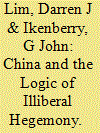

|
|
|
|
|
| Summary/Abstract |
We develop a theoretical logic and character of a Chinese model of international order. We begin by considering general problems of power transition and hegemonic order-building, with reference to the American experience with liberal hegemony. China will, like all powerful states, seek an order that protects its interests. But unlike its predecessors, China faces an existing order containing elements that threaten its domestic political and economic model. We describe this domestic model and consider how it might be defended at the international level—embedded in the logic and organizational principles of hegemonic order. Our contribution is to theorize the consequences of China’s hegemonic interests, including domestic preservation, and its order-building practices, for the operation and underlying character of a China-led hegemonic order. Though not inherently illiberal in form, we outline how the emergent order could generate illiberal outcomes. This article therefore theorizes the concept of illiberal hegemony.
|
|
|
|
|
|
|
|
|
|
|
|
|
|
|
|
| 4 |
ID:
192018
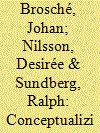

|
|
|
|
|
| Summary/Abstract |
Civil wars that appear to observers to be the most complex—even using a colloquial understanding of the concept—are also those that seem to register the most intense fighting, the most prolonged spells of war, and the most resistance to durable conflict resolution. But what does it really mean for a civil war to be complex? We currently lack a concept of “civil war complexity” that can help us better understand the most important variations in civil wars across time and space. To address this gap we develop a conceptualization of “civil war complexity” consisting of three dimensions—“actor complexity,” “behavior complexity,” and “issue complexity”—and demonstrate how they manifest empirically. We also highlight this conceptualization’s utility—and the danger of overlooking it—through the case of Darfur. This conceptualization paves the way for a new research agenda that explores how civil wars differ in terms of their complexity, the causes and consequences of civil war complexity, and how to refine conflict resolution techniques and strategies.
|
|
|
|
|
|
|
|
|
|
|
|
|
|
|
|
| 5 |
ID:
192015
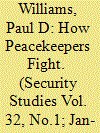

|
|
|
|
|
| Summary/Abstract |
Contrary to popular perceptions, United Nations (UN) peacekeepers engage in combat fairly frequently. A central challenge facing the UN is thus calibration between force and politics: ensuring the organization’s combat power is harnessed to viable political strategies for peace. However, the epistemic community on peacekeeping remains deeply divided between skeptics and proponents of “robust” operations, where peacekeepers are expected to use force to implement mission mandates. This article suggests that militarily effective, robust peacekeeping is most important for improving civilian protection and ensuring mission credibility in theaters where there is no peace to keep; proposes a novel framework and typology to assess combat effectiveness in UN peace operations; and compiles descriptive statistics for the 1948–2020 period. Finally, case studies of four battles involving UN peacekeepers in the Democratic Republic of the Congo illuminate the conditions that are conducive to the UN’s combat effectiveness.
|
|
|
|
|
|
|
|
|
|
|
|
|
|
|
|
| 6 |
ID:
192019
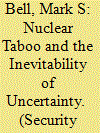

|
|
|
|
|
| Summary/Abstract |
The nuclear taboo—a strong normative inhibition on the use of nuclear weapons—is one of the most important concepts in the study of nuclear weapons.Footnote1 In the last few years, however, the idea of the taboo has come under attack. Notably, a series of studies have shown that mass publics appear quite comfortable with using nuclear weapons.Footnote2 When given hypothetical scenarios in which nuclear use might be considered, publics appear willing to use nuclear weapons, and concerns about (im)morality appear to weigh less heavily than narrow assessments of military utility. In the latest contribution to this research agenda, Janina Dill, Scott D. Sagan, and Benjamin A. Valentino (hereafter DSV) demonstrate that not only Americans appear comfortable with nuclear use.Footnote3 Surveying publics in France, Israel, the United Kingdom, and the United States, they show similar patterns in each country: respondents are surprisingly willing to use nuclear weapons and appear responsive to assessments of military utility. Scholars previously raised the possibility that US publics might be unusual as a caveat qualifying prior findings.Footnote4 DSV’s argument and evidence thus represent an important contribution, showing that prior findings can in fact be replicated across a range of democracies.
|
|
|
|
|
|
|
|
|
|
|
|
|
|
|
|
| 7 |
ID:
192023


|
|
|
|
|
| Summary/Abstract |
Thinking deeply about how a nuclear war might break out is neither easy nor enjoyable. Scholars do so, however, because we hope that contemplating the pathways by which such a cataclysm might happen today could lower the risk one will happen in the future. For that reason, we owe a special thanks to Mark S. Bell, Målfrid Braut-Hegghammer, Yogesh Joshi, Benoît Pelopidas, and Kjølv Egeland, who have joined us in this discomforting mission. Our article found that different states have similar “kettles of hawks” who favored nuclear use across different scenarios. We are pleased that the contributors to this exchange have formed “a parliament of owls” that has raised important questions, forwarded valuable insights, helped us clarify key points in our own thinking, and pointed the way toward critical new research on nuclear war.
|
|
|
|
|
|
|
|
|
|
|
|
|
|
|
|
| 8 |
ID:
192016


|
|
|
|
|
| Summary/Abstract |
Why did modern terrorism arise as a form of political violence? Scholars have located its origins in the mid-nineteenth century, a development that culminated in a global wave of terrorism and contributed to the outbreak of World War I. Despite consensus on its period of origin, we lack any explanation for why this development occurred. This article forwards a social theory for the origins of modern terrorism. Civic associations, which proliferated globally in the nineteenth century, provided the opportunity and motivation for the development of terrorism. Associations not only fostered the social and human capital necessary for terrorism; they also frequently generated grievances through an inability to enact political change and via ideological propaganda. I test this theory using an original global dataset of terrorist groups formed between 1860 and 1945. Statistical analysis reveals that cities with a YMCA, an exogenous indicator of associationism, were much more likely than those without to see the formation of terrorist groups. Additionally, terrorist groups are formed during civil wars, indicating that armed conflict can spur dramatic innovations in violent contention.
|
|
|
|
|
|
|
|
|
|
|
|
|
|
|
|
| 9 |
ID:
192022
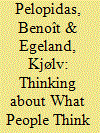

|
|
|
|
|
| Summary/Abstract |
What do people really think about nuclear weapons? Responding to Dill, Sagan, and Valentino's “Kettles of Hawks” in Security Studies 31, we examine the inconsistency between different surveys of public attitudes toward nuclear weapons use. We maintain that different survey techniques tap into disparate layers of opinion—each of which is “real” in their own way and of analytical value depending on the research question being asked. We conclude by reflecting on scholarly responsibility and the dilemmas associated with researching and communicating about potentially sensitive knowledge.
|
|
|
|
|
|
|
|
|
|
|
|
|
|
|
|
| 10 |
ID:
192021


|
|
|
|
|
| Summary/Abstract |
Janina Dill, Scott Sagan and Benjamin Valentino have demonstrated how calculations over the morality of contending norms may influence public's readiness to use nuclear weapons. I argue that such atomic dispositions are highly contingent on the nature of the adversary. Public may react differently to various nuclear targets because adversaries evoke different levels of retributiveness. When deciding between the lives of fellow citizens and those of foreign noncombatants, a bargain is easier to reach against targets which evoke feelings of hatred and anger due to historical, cultural or domestic political reasons. Using the Indian case, I demonstrate why the variance in the character of the threat is a substantive issue. Specifically, I show why the India-China dyad exhibits a greater degree of normative prohibition compared to the India-Pakistan dyad.
|
|
|
|
|
|
|
|
|
|
|
|
|
|
|
|
|
|
|
|
|